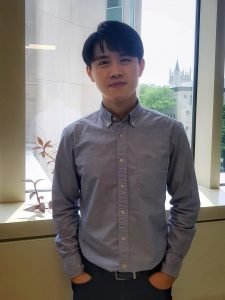Nanotechnology at Northwestern
Meet Hun Park, a postdoctoral fellow in the Huang Group
June 05, 2020
Hun Park is a postdoctoral fellow in Prof. Jiaxing Huang’s lab, which focuses on materials science and engineering.

Where are you originally from?
I’m from Seoul, South Korea.
Where did you complete your undergraduate degree?
I completed my undergraduate degree at Hanyang University.
What year are you now?
I am in my first year of post-doc.
When did you first become interested in materials science and engineering?
During my Ph.D. course I encountered various materials like polymers, ceramics and metals. Each of these materials has its own characteristics, like a person does, and I enjoyed breaking the ice and getting to know them.
Usually, I ask questions by doing experiments and the materials answer with the results. Sometimes, they tell me a secret nobody else knows. The thing I love most is that the materials never lie. If it seems that they do, it only means that I asked in the wrong way or misinterpreted their answers.
How do you explain what you study to non-scientists?
Like an architect, I design and build a structure for a specific purpose. The biggest difference from an architect, I think, lies in the scale of building blocks I use: nanoscale (a length scale 100,000 times smaller than that of human hair width). They are generally invisible and impalpable so specialized techniques are required to analyze and assemble them. At this small scale, they begin to show intriguing properties which cannot be observed from their bulk counterparts at a visible length scale. I’ve studied such properties and developed novel assembly techniques to find new applications.
What are you working on now, and what do you hope to achieve?
I am working on developing a mask-inspired structure which releases antiviral chemicals into exhaled droplets on contact. When we take a closer look at a commercial face mask, it can be seen that the mask consists of densely packed and randomly intertwined fibers. They form a physical barrier to airborne particular matters and exhaled droplets as providing narrow, tortuous pathways. Depending on the quality of the mask, however, some of the droplets succeed in passing through the mask as bouncing forward in the tortuous structure. If they contain viruses, this could result in the spread of the viruses.
Hence, I am trying to modify the fibers to release antiviral chemicals when the droplets bounce on (i.e., interact with) them during the escape. I hope, if it is successful, the new mask-inspired structure could slow and even prevent the spread of viruses.
Prof. Huang recently co-authored an article that urged physical scientists and engineers to think about how they can help during a global crisis like COVID-19. What do you think about your own role in a crisis?
First of all, I’d like to thank the public health and healthcare workers who are fighting at the frontline of this pandemic. Compared to what they do, my own work may be indirect, take a long time, and could even fail. Nevertheless, I want to keep devising and developing better personal protective equipment that could help them work more efficiently and safely.
As described in the article, there are a lot of uncovered research topics in which physical scientists can take a part to slow or prevent the spread of viruses. It is impossible for me to cover all the topics. Instead, I hope my ongoing research could contribute to setting a scientific foundation for them to achieve more, and thereby could encourage more scientists to participate in this global challenge.
Can you tell me about a mentor who has helped you in your career?
My Ph.D. advisor, Prof. Tae Hee Han at Hanyang University. I think his educational philosophy worked well with me. Usually, he set a project aim as broadly as possible and let me play freely within it rather than managing my individual steps. He stepped in only when I was stuck on a specific point, and taught me how to see a forest instead of a single tree. All of these were helpful for developing my own philosophy on MSE.
What has been a highlight of your time at Northwestern?
At this time last year our group members often played beach volleyball at Clark Street Beach. Although I had never played it before, I enjoyed running, jumping and sliding on the beach. I hope to play volleyball again this summer once we overcome this pandemic.
What are your hobbies outside of the lab?
One of my hobbies is singing and listening music. It helps me release stress. I also love to go jogging around the Lake Michigan in the morning.